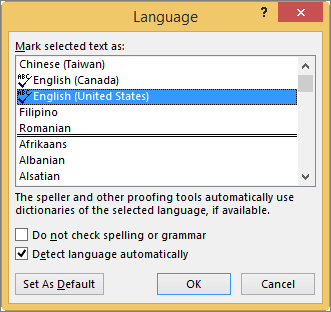

Click Do not check selling or grammar twice to remove the tick and spell check the entire email. Select the entire message then switch on the Options tab and click on Language. You'll need to change the check spelling option manually for each message.
#WHY SPELL CHECK IS CHANGE FONTS IN WORD 2016 MAC#
The best solution would be to use stationery or another method to inset the text, not signatures… if only the Mac version supported stationery or autotext. When I edit the text, spell checking doesn’t work. We use signatures to add prepared text to a message. The Set Language dialog is identical to the one in Outlook 2010: Deselect the Do not checking spelling and grammar option near the bottom of the dialog.Ī Mac user had a question about spellchecking email: In Outlook 2007, expand the Spelling button and choose Set Language. In Outlook 2010 and above, select the entire message body ( Ctrl+A to select all) switch to the Review tab, Language button, Set Proofing Language command and remove the check from Do not check spelling or grammar. If F7 doesn't check the signature, you will need to change the style so that it doesn't skip text when checking the spelling. Or press F7 to run spell check manually on the entire message. You can select just the text you typed and Cut it ( Ctrl+X), then use Paste Special, as text to paste it in the message body area above the signature, if you know where the signature begins. Note: this will remove formatting, images, and hyperlinks from the message. Note: the RFC specifies two dashes followed by a space: "- " as the signature separator.Īdding the dashes to the signature won’t help you with the current message though – to fix spell check in the message, you can select all and cut the message body (including the signature) then use Paste Special, As Text to paste it back into the message in plain text format. Why two dashes? The RFC’s recommend using it to separate the message from the signature. If you have accounts that you do not want to use a signature on, create a blank signature that contains just the dashes & space to use when you don't want to use a signature. Repeat to turn the formatting characters off.) (To see the pilco and other formatting marks, press Ctrl+Shift+8 to toggle them on. The answer is definitely positive, as discussed in this tip. You may wonder if the text you place in a text box can be spell checked. This will help you to see where the signature begins and prevent typing in the signature area. Text boxes are a common design element in a document. Clear the check box, close the dialog box, and do your spelling check again.Edit your signatures to include two dashes and a space ("- ") above the actual signature. To see if this is the case, select the text in the text box, then display the Language dialog box (choose Tools | Language | Set Language.) If the check box entitled "Do Not Check Spelling or Grammar" is selected, then you have discovered your problem. Instead, the text itself could be marked to be ignored by the spell checker. If you still cannot get the spell-checker to pay attention to the text in your text boxes, the problem may not be related to the use of text boxes.

When the frame's text is finished, then the spell-checker picks right back up, at the point in the main text immediately following the frame's anchor. When the anchor point for the frame is encountered by the spell-checker, all of the text in the frame is spell-checked. Frames are placed on the same layer as the text, as well. Another approach is to convert the text boxes to frames (as described in other issues of WordTips). For instance, you could use tables instead of text boxes they are placed on the text layer and processed with the rest of the text by the spell-checker. If this wait-until-last approach to spell-checking bothers you, then you may want to use a different design element rather than text boxes. The spell-checker finishes everything on the text layer before it starts checking things on the other layers of the document. Why? Because text boxes are not on the same "layer" as the rest of the document.

If you start doing a spell-check at the beginning of your document, Word goes through all five pages of the text before it actually does the spell-check on the text boxes. Let's say that you have a five-page document, with text boxes on pages one and two. In testing this problem, we actually found out that the text in text boxes is spell-checked it is not ignored. She uses text boxes extensively for her layout design, and Word seems to ignore the text in the text boxes when it comes time to spell check. Laney asked if there was a way to spell-check text within text boxes.


 0 kommentar(er)
0 kommentar(er)
